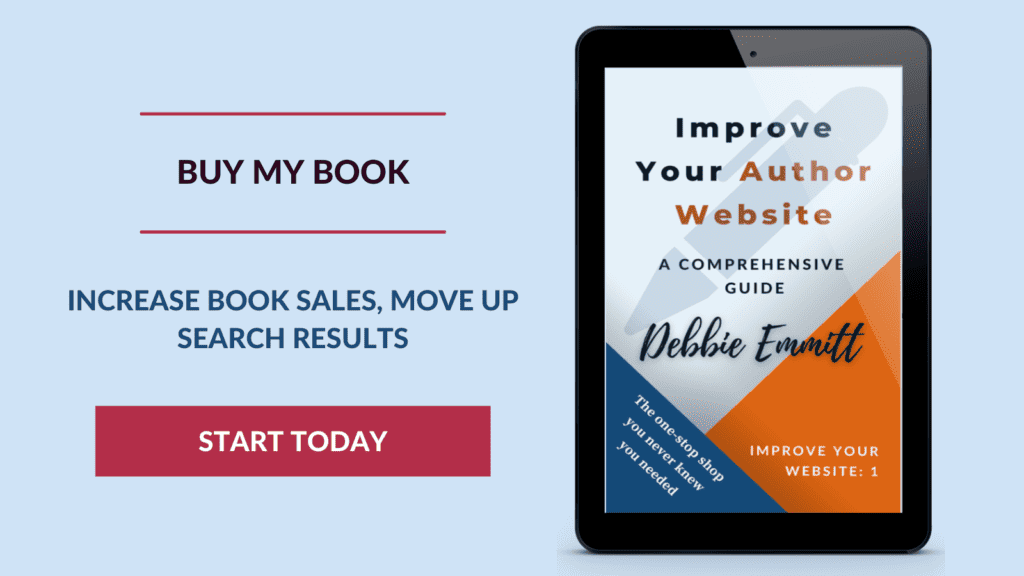
What’s the best way for people to get in touch with you via your author website? Email address or contact form? Dive into the pros and cons of each and discover which approach is right for you.
Why provide a contact method?
If you don’t have an easy way for people to contact you on your author website, you could miss out on more than fan mail.
Imagine this scenario: a busy agent or publisher comes to your site to find a quick way to contact you.
They search in vain for a contact link in your site menu, or on the homepage, and leave without having found it.
You just lost a book deal or an offer of representation.
Contact information is not only for agents and publishers. Offering your primary site audience (e.g. current or prospective readers) a contact method lets them know you’re interested in hearing from them, and that you’re open to questions or feedback.
Risk missing out on more than fan mail by not having a contact method on your author website – Email address or contact form on your author website? Share on XBut I’m on Facebook, Twitter, Instagram…
True, people can contact you via those places, but they are primarily marketing platforms.
But I have an email list sign-up form…
Great! However, this isn’t the same as a contact form. A sign-up form is one-way communication, for you to market to your main audience.
Contact information says to people, “I’d love to hear from you!” Of course, if you don’t want people to get in touch, that’s a whole other ballgame. Just be aware of the message you’re conveying, or of the opportunities you could be missing out on, if you choose to remain incommunicado.
Contact form or email address?
The two methods for people to contact you via your author website are through a contact form (see mine for an example) or your email address. There are pros and cons to each.
Contact form advantages
- Security – Your email address isn’t published for spambots to take advantage of. In addition, you can protect yourself against spambots by adding a CAPTCHA field (when users have to prove they’re human by ticking a box or entering text), or by adding a hidden field (a honeypot) that spambots will detect but humans won’t. Make sure the honeypot field is clearly marked for people using screen readers.
- Good user experience – If kept short (just fields for an email address and a message, possibly also name fields), most people will be happy to fill it in. Also, visitors don’t have to open their email software; they can stay on your site. This is a bonus for you and them!
- Practical – You can embed the form on a page, then link to it from anywhere on your site.
- Professional – A contact form looks more professional than just an email address.
- Versatile – Depending on how you build your form, or which plugin you use, you can add extra features such as a newsletter sign-up box.
- Organised – You can set the text for the subject line of all messages, so that you can see at a glance in your inbox which emails are from your website. This can also help you to filter these messages. Also, you may have a PA who needs to see certain emails sent to you. You can set up a rule so they receive only form responses, not all emails.
- Time saver – You can add drop-downs and extra fields to your contact form to filter messages to different mailboxes, or to gather extra information from your visitors, e.g. nature of their query. Beware of making the form too complex, though, or people won’t use it.

Contact form disadvantages
- Some visitors are put off by having to complete a form, especially if it is long.
- Forms can be seen as less personal.
- Forms don’t always offer users the option to receive a copy of their message, so they have no record of it.
Email address advantages
- Visitors can easily see your email address and add you to their contacts.
- Some people may prefer to contact you using their email client.
- Users have a record of the email sent.
Email address disadvantages
- Spambots may harvest your email address if it isn’t encoded.
- Any attachments, email signatures, or other files associated with emails sent to you will take up valuable space in your inbox.
- Anyone can send an infected file to your inbox.
On balance, a contact form is the best method for most site owners, and the most secure. Having tried both over the years, this is my firm favourite.
Website contact top trumps! A contact form beats a simple address every. single. time. – Email address or contact form on your author website? Share on XWhere to put your contact details
There’s no hard and fast rule, except to make them easy to get to from the homepage, and ideally from every page on your site.
If you’re using a contact form, you can embed it into its own page and link to it from your main site navigation.
If you prefer to provide an email address, you could put it in your site footer (remember to encode it so you don’t get hammered with spam). It’s still wise to have a Contact page as well that you link to from the main menu. Flesh this out with social media links, reasons why people may want to get in touch with you, and other information.
How to add a contact form to your website
If you have a WordPress site, you can use a plugin. I use WPForms and haven’t had any issues with it.
I won’t reinvent the wheel and list the steps to create a form using WPForms, when others have already described this so well. Follow WPBeginner’s clear instructions on how to create a contact form in WordPress.
If you don’t use WordPress for your site, your CMS is likely to have a simple way for you to create a contact form. Search for instructions using your favourite search engine, or contact your CMS admin team for advice.
What’s your story?
Which contact method do you prefer, email address or contact form? Let me know in the comments!
I’d also be fascinated to know if you have had opportunities that came your way through your contact info on your site, that you would have otherwise missed out on.









Leave a Reply